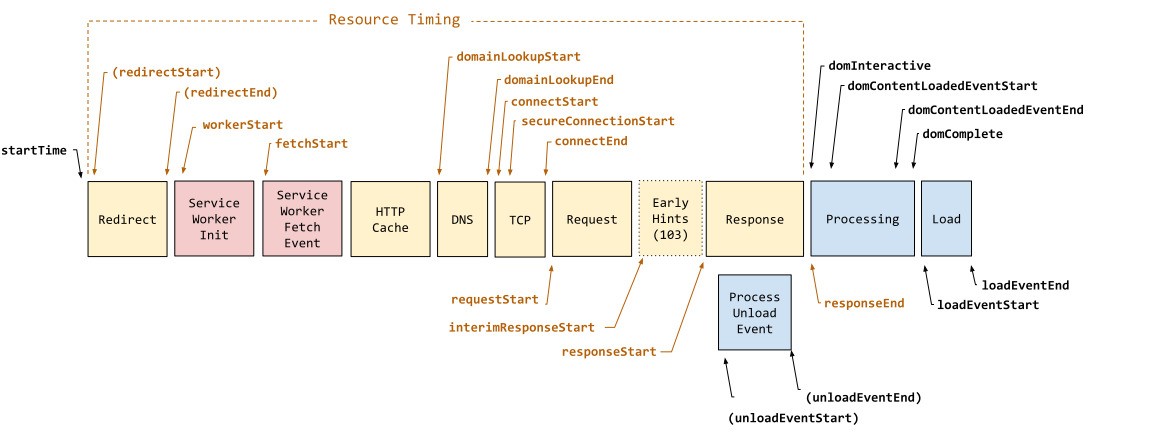Introduction
In today’s digital landscape, website speed plays a crucial role in user experience and search engine ranking. One critical aspect of website speed is the Time to First Byte (TTFB). This article will delve into what TTFB is, why it matters, and how to optimize it to ensure your website performs at its best.
Understanding Time to First Byte (TTFB)
What is Time to First Byte (TTFB)?

(A diagram of network request phases and their associated timings. TTFB measures the elapsed time between startTime and responseStart.)
Source – web.dev
Time to First Byte (TTFB)is a metric that measures the time it takes for a user’s browser to receive the first byte of data from the server after a request is made. This metric includes the time taken for DNS resolution, establishing the connection, and waiting for the server to process the request and send back the initial response. Essentially, TTFB reflects the responsiveness of a web server.
Why Time to First Byte (TTFB) Matters
TTFB is a critical factor in overall website performance. A high TTFB can lead to longer page load times, which can negatively impact user experience and lead to higher bounce rates. Additionally, search engines like Google consider TTFB as part of their ranking algorithms. Websites with greater speed are more likely to appear higher in search results, resulting in more visitors and visibility.
Factors Affecting Time to First Byte (TTFB)
Server Response Time
The primary factor affecting TTFB is the server’s response time. This includes how quickly the server processes requests and sends back the first byte of data. Factors such as server load, server hardware, and software configurations can all influence response times.
Network Latency
Network latencyrefers to the time it takes for data to travel between the user’s browser and the server. This can be affected by the physical distance between the user and the server, the quality of the network infrastructure, and the presence of any network congestion.
DNS Lookup Time
Before a connection to the server can be established, the browser must resolve the domain name to an IP address. DNS lookup time is the time it takes to perform this resolution. Faster DNS resolution can contribute to a lower TTFB.
What Defines an Optimal Time to First Byte (TTFB) Score?

(Good TTFB values are 0.8 seconds or less, and poor values are greater than 1.8 seconds.)
Source – web.dev
Since TTFB impacts user-focused metrics like First Contentful Paint (FCP) and Largest Contentful Paint (LCP), it’s crucial for your server to respond to navigation requests swiftly, ensuring that the majority of users (75th percentile) experience an FCP within the “good” range. Generally, websites should aim for a TTFB of 0.8 seconds or less to achieve optimal performance.
How to Measure Time to First Byte (TTFB)
Using Developer Tools
One of the easiest ways to measure TTFB is by using the developer tools built into most modern web browsers. For example, in Google Chrome, you can open the Developer Tools, go to the “Network” tab, reload the page, and check the “Waterfall” chart to see the TTFB for each request.
Online Tools and Services
Several online tools and services can measure TTFB for you. Tools like WebPageTest, Pingdom, and GTmetrix provide detailed insights into your website’s performance, including TTFB.
Eliminate Render Blocking Easily With Website Speedy
Boost Speed NowStrategies to Optimize Time to First Byte (TTFB)
Choosing the Right Hosting Provider
Your choice of hosting provider can significantly impact your TTFB. Look for providers known for their performance and reliability. Consider using managed hosting services that optimize server configurations for speed.
Using a Content Delivery Network (CDN)
A Content Delivery Network (CDN) distributes your website’s content across multiple servers located around the world. By serving content from a server closest to the user, CDNs can reduce network latency and improve Time to First Byte (TTFB).
Optimizing Server Configurations
Properly configuring your server can lead to significant improvements in TTFB. This includes using efficient web server software like Nginx or LiteSpeed, enabling compression (e.g., Gzip), and ensuring your server has sufficient resources (CPU, memory, etc.).
Implementing Caching Mechanisms
Caching can reduce the time needed to generate responses for repeated requests. Implement server-side caching to store copies of dynamic content and reduce the load on your server. Browser caching can also help by storing static resources locally on the user’s device.
Minimizing HTTP Requests
Each additional HTTP request adds to the overall response time. Minimize HTTP requests by combining files (e.g., CSS and JavaScript), using image sprites, and reducing the number of third-party scripts.
Website Speedy: The Ultimate Tool for Optimizing Time to First Byte (TTFB)
To optimize your website speed effortlessly, consider using Website Speedy. This tool excels in reducing TTFB, making it the best choice for website speed optimization. With Website Speedy, you can ensure your site loads faster and provides a better user experience.
Key Features of Website Speedy
Enable Lazy Loading
Non-essential resource loading is postponed until it is required by lazy loading. This can enhance TTFB and drastically cut down on initial load times.
Eliminate Render Blocking
Render-blocking resources delay the rendering of a web page. Website Speedy identifies and eliminates these resources, improving page load times and Time to First Byte (TTFB).
Improving Total Blocking Time (TBT)
Total Blocking Time (TBT) measures the total time during which the main thread is blocked, preventing user interactions. Website Speedy optimizes Total Blocking Time (TBT), enhancing overall responsiveness.
Image Optimization
Images can be a major factor in page load times. Website Speedy automatically optimizes images for faster loading without compromising quality.
BigCommerce Core Web Vitals Optimization
Website Speedy is the best tool to optimize and fix BigCommerce Core Web Vitals. It can boost your BigCommerce store speed effortlessly, ensuring your site meets the performance standards set by Google.
Best Practices for Ongoing Time to First Byte (TTFB) Optimization
Regular Monitoring
Regularly monitor your TTFB using tools like those mentioned earlier. Continuous monitoring allows you to identify performance issues as they arise and address them promptly.
Keeping Software Up-to-Date
Ensure your server software, CMS, plugins, and themes are always up-to-date. Updates often include performance improvements and security fixes that can help reduce Time to First Byte (TTFB).
Analyzing and Reducing Server Load
Monitor server load and optimize your server’s performance by reducing resource-heavy processes. This might include optimizing databases, using efficient algorithms, and load balancing
Implementing Efficient Database Queries
Inefficient database queries can significantly slow down server response times. Ensure your database queries are optimized and indexed properly to reduce the time taken to fetch data.
Leveraging Browser Caching
Browser caching stores static files on the user’s device, reducing the number of requests to the server. Implement proper cache-control headers to leverage browser caching effectively.
Conclusion
Time to First Byte (TTFB) is a critical metric that directly impacts your website’s performance and user experience. By understanding what TTFB is and employing strategies to optimize it, you can ensure your website loads quickly and efficiently. Tools like Website Speedy can make this process effortless, providing solutions like lazy loading, eliminating render-blocking resources, and optimizing images. Keep monitoring and optimizing your TTFB to maintain a fast and responsive website.

Want to read this blog offline?
No worries, download the PDF version
now and enjoy your reading later…
 Download PDF
Download PDF Frequently Asked Questions (FAQs)
What is a good TTFB?
Typically, a good TTFB is 200 milliseconds or less. This suggests a responsive and quick server.
How can I check my website’s TTFB?
You can check your website’s TTFB using browser developer tools or online services like WebPageTest, Pingdom, and GTmetrix.
Does Time to First Byte (TTFB) affect SEO?
Yes, TTFB can affect SEO. Google uses page speed as a ranking factor, and a faster TTFB can contribute to better search engine rankings.
What causes a high TTFB?
High Time to First Byte (TTFB) can be caused by factors such as slow server response times, high network latency, inefficient server configurations, and DNS lookup delays.
How can Website Speedy help reduce TTFB?
Website Speedy helps reduce Time to First Byte (TTFB) by enabling lazy loading, eliminating render-blocking resources, improving total blocking time, and optimizing images. It is particularly effective for BigCommerce store speed optimization and fixing BigCommerce Core Web Vitals.
By implementing these strategies and utilizing tools like Website Speedy, you can significantly improve your website’s TTFB, providing a better user experience and enhancing your site’s performance.















































